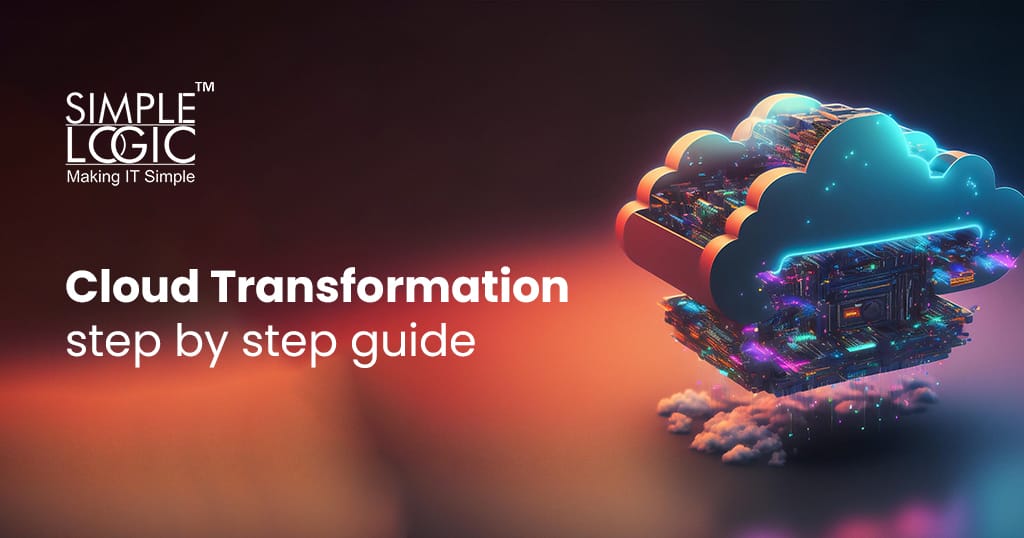Cloud Transformation Step-by-Step Guide
Have you ever wondered how businesses manage their operations so smoothly without relying on heavy, on-site servers?
That’s where cloud transformation steps in. At its core, cloud transformation is the process of moving your organization’s digital assets—such as applications, data, and IT resources—to cloud-based platforms. This transition enables businesses to become more agile, cost-effective, and scalable.
Cloud computing eliminates the need for expensive on-premise infrastructure. Instead, it allows you to access resources like servers, storage, and databases over the internet. With just a few clicks, you can adapt your operations to meet changing demands, making it an essential move for modern businesses.
Simple Logic IT can help you seamlessly navigate this transition, ensuring a smooth and efficient cloud transformation process tailored to your business needs.

The Complete Cloud Transformation Guide
In today’s competitive business environment, organizations are increasingly adopting cloud transformation to enhance efficiency, scalability, and innovation. Whether you’re moving from outdated systems or building a new cloud-based infrastructure, a comprehensive cloud migration strategy is essential for success. This guide outlines the key steps in the cloud transformation journey—from assessing your current IT infrastructure to optimizing post-migration performance.
Step 1: Inventory Your IT Infrastructure
Before engaging in your cloud transformation journey, it’s crucial to understand your current IT infrastructure. Cataloging your hardware, software, and data assets provides a clear picture of your existing setup.
Ask yourself: Why does my organization need cloud infrastructure? Common concerns such as sluggish application performance, data silos, or limited scalability will guide your transformation strategy.
Additionally, perform a thorough cost analysis by comparing the Total Cost of Ownership (TCO) of your current infrastructure with the anticipated cloud expenses. This helps to assess the financial impact of moving to the cloud.
Lastly, ensure your cloud strategy aligns with industry standards and best practices to maintain data security and compliance.
Step 2: Set Specific Goals
Your cloud transformation should be guided by clear, achievable objectives. These goals should reflect your overall business aspirations, such as:
- Boosting operational efficiency
- Enhancing customer experiences
- Reducing infrastructure costs
- Improving data security
By setting specific goals, you’ll create a roadmap that ensures your cloud migration is aligned with your business needs.
Step 3: Choose the Right Cloud Model
Selecting the right cloud deployment model is essential to the success of your transformation. Depending on your requirements, you can choose from:
- Public Cloud: Offers scalability and cost-efficiency.
- Private Cloud: Provides enhanced control and security for sensitive data.
- Hybrid Cloud: Combines public and private cloud benefits for greater flexibility.
Each model caters to different business needs, so evaluate your workload demands and design a strategy that balances performance and cost-effectiveness.
Step 4: Plan Your Cloud Migration
Migration is a critical step in your cloud transformation journey. A well-defined plan ensures minimal disruptions and a smooth transition. Key considerations include:
- Workload Compatibility: Not all workloads are suited for a cloud-native approach. Identify which ones need adjustments.
- Data Migration Strategy: Decide whether to perform a one-time migration, gradual sync, or hybrid transfer method.
- Security and Compliance: Prioritize data security and ensure regulatory compliance during the migration process.
Additionally, modernize applications to improve performance and scalability. A thorough risk assessment should also be conducted to mitigate any potential issues during the migration phase.
Step 5: Choose the Best Cloud Provider
Selecting the right cloud provider is critical for a successful transformation. Consider providers like AWS, Azure, and Google Cloud, and evaluate them based on:
- Service offerings
- Global data centre presence
- Ecosystem alignment
Look for features such as flexible pricing models (pay-as-you-go, reserved instances, spot instances) and support for migration ease. Also, ensure your chosen provider helps minimize vendor lock-in by offering open standards and flexibility.
Step 6: Train Your Team
Transitioning to the cloud requires a skilled workforce. Conduct comprehensive training sessions tailored to different roles, focusing on:
- Cloud platform navigation
- Security protocols
- New workflows and collaboration tools
A well-equipped team will make the adoption of cloud technologies seamless and efficient.
Step 7: Monitor and Optimize
Post-migration, continuous monitoring is essential to ensure optimal performance. Use cloud analytics and monitoring tools to track security, costs, and system efficiency.
Regularly review and optimize your infrastructure to meet evolving business needs, ensuring scalability and minimizing downtime.
Step 8: Innovate with Cloud Capabilities
Beyond migration, the cloud offers advanced capabilities that drive innovation. Take advantage of AI/ML, IoT, and big data analytics to unlock new opportunities and enhance your competitive edge.
A successful cloud transformation is more than just modernization—it’s an opportunity to transform your business into a more agile, secure, and innovative entity.
Why Choose Simple Logic IT?
At Simple Logic IT, we know that every business is unique, especially when it comes to cloud transformation. That’s why we offer tailored solutions to help you smoothly transition to the cloud and achieve your goals.
Here’s why businesses trust us:
Personalized Plans: We create cloud migration plans that match your specific needs, ensuring a hassle-free experience.
Expert Support: Our certified professionals handle the technical details with minimal downtime, so you can focus on what matters most—running your business.
Complete Assistance: From start to finish, we provide support—from planning to monitoring even after migration.
Data Security: We keep your data safe and secure throughout the entire transformation process.
Choosing Simple Logic IT means working with a team that’s dedicated to making your cloud journey successful and stress-free.

Wrapping Up for Maximize ROI with a Strategic Cloud Transformation Plan
Cloud transformation is no longer a luxury but a necessity in today’s fast-paced digital world. By following this step-by-step guide, you can streamline your transition to the cloud and unlock its full potential. Whether you want to reduce costs, improve scalability, or enhance collaboration, the cloud offers endless opportunities.
Ready to leap? Partner with experts like Simple Logic IT to ensure a smooth and successful transformation journey. Together, we can help your business soar to new heights in the cloud.
FAQs on Maximize ROI with a Strategic Cloud Transformation Plan
-
What is cloud transformation?
- It’s the process of migrating an organization’s digital assets to cloud-based platforms to enhance agility and scalability.
-
Why is a strategic cloud transformation plan important?
- It ensures a structured approach, aligning cloud adoption with business objectives for optimal ROI.
-
What are the key steps in developing a cloud transformation strategy?
- Assess current infrastructure, define objectives, choose the right cloud model, plan migration, and implement governance.
-
How does cloud transformation impact data security?
- It enhances security by leveraging advanced cloud security measures but requires diligent compliance and monitoring.
-
What challenges might arise during cloud transformation?
- Potential challenges include data migration issues, integration complexities, and managing costs.





